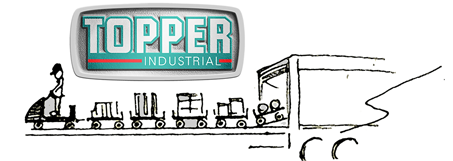Published February 2, 2016 by 
Replace one-load-at-a-time delivery to improve throughput and lower cost of quality
Quality professionals in most manufacturing plants still have safety under their area of responsibility. Safety has been a growing concern in the workplace for decades, and in warehouse operations, forklift safety is one of the biggest.
OSHA statistics report that more than 100 workers are killed from forklift accidents and 20,000 are injured annually in the United States. In cases of injury or death, a company is liable to pay considerable costs for damages, and injured workers can miss on average 61 days of work due to the injury.
One way to address this problem is by reducing the use of forklifts. “State-of-the-art tow tractors coupled with industrial cart systems act as trains carrying multiple loads in one trip; this type of solution is very efficient for moving material and can replace one-load-at-a-time delivery,” says Ed Brown, founder of Topper Industrial and a proponent of the Fork Truck Free (FTF) movement in North America. “Cart-based solutions have evolved where they can operate in a wide range of applications, including parts delivery to a production line, kitting, or for sequenced cart orders delivering smaller loads more frequently. There is a direct positive impact on throughput.”
What initially drove the FTF movement was safety and lean manufacturing principles. However, an added benefit is that forklift-free environments drive down costs normally incurred from labor wages, medical costs, and training expenses, as well as costs from facility, equipment, and product damage due to forklifts.
Forklifts are expensive to operate, averaging approximately $62,000 per year in the United States. “Forklift operators account for 96 percent of the operating cost over the vehicle life,” says Jeff Christensen, vice president of products and services at Seegrid VGVs (vision guided vehicles). “Whereas with an automated tugger solution replacing manned forklift travel, the vehicle can operate for approximately $3 per hour, 24/7.”
Brown detailed some of the reasons why manufacturing operations managers are using the FTF approach in conjunction with quality initiatives. These include savings on fork truck maintenance, warehousing, economically more efficient material handling, and an overall decrease in traffic since all forklifts and tuggers abide by one-way traffic.
“In the large automotive tier 1, 2, and 3 supplier network, the throughput is improved because the flow of material-handling operations becomes transparent, and work-in-process at manufacturing and assembly is often reduced by 75 percent,” says Brown. “Eliminating rack storage equals added manufacturing space, and we typically see elimination of up to 66 percent of fork trucks being used.”
Displaced fork truck drivers are moved to tugger-driving positions or new value-added positions. In one implementation of a tugger and delivery cart system, the number of vehicle trips to a work cell and back per day was reduced from 23 passes made by a conventional fork truck to only five passes per day by a tugger and cart system. All while contributing to the same completed work.
Topper Industrial has implemented a variety of FTF initiatives and solutions with Detroit Diesel Corp., Honda Motor Co., Kia Motors Corp., Ford Motor Co., Chrysler, Aramark, Johnson Controls, Whirlpool Corp., and Caterpillar Inc. In each company the push for FTF environments helped bring about improved throughput and productivity with reduced labor costs. The switch to forklift-free environments means that workers are no longer required to move heavy loads manually or with the use of vision-guided vehicles.
The most encouraging aspect to the FTF movement in 2016 will be the improved communication between quality and operations management team members. The goals of labor optimization, lean manufacturing efficiency, and safety for all workers are cooperative processes. Throughput objectives seem to advance a new era of cooperation and communication. Throughput focus is the next layer of lean manufacturing.


